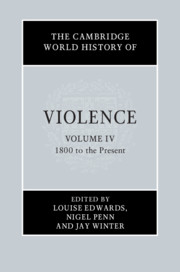Book contents
- The Cambridge World History of Violence
- The Cambridge History of Violence
- The Cambridge World History of Violence
- Copyright page
- Contents
- Figures and Maps
- Contributors to Volume IV
- Introduction to Volume IV
- Part I Race, Religion and Nationalism
- 1 Empires and Indigenous Worlds: Violence and the Pacific Ocean, 1760 to 1930s
- 2 Heresy and Banditry: Religious Violence in China since 1850
- 3 Violence, Non-Violence, the State and the Nation: India, 1858–1958
- 4 Racial Violence in the United States since the Civil War
- 5 Religion and Violence in Modern South Asia
- 6 Coercion and Violence in the Middle East
- Part II Intimate and Gendered Violence
- Part III Warfare, Colonialism and Empire in the Modern World
- Part IV The State, Revolution and Social Change
- Part V Representations and Constructions of Violence
- Index
- References
5 - Religion and Violence in Modern South Asia
from Part I - Race, Religion and Nationalism
Published online by Cambridge University Press: 13 March 2020
- The Cambridge World History of Violence
- The Cambridge History of Violence
- The Cambridge World History of Violence
- Copyright page
- Contents
- Figures and Maps
- Contributors to Volume IV
- Introduction to Volume IV
- Part I Race, Religion and Nationalism
- 1 Empires and Indigenous Worlds: Violence and the Pacific Ocean, 1760 to 1930s
- 2 Heresy and Banditry: Religious Violence in China since 1850
- 3 Violence, Non-Violence, the State and the Nation: India, 1858–1958
- 4 Racial Violence in the United States since the Civil War
- 5 Religion and Violence in Modern South Asia
- 6 Coercion and Violence in the Middle East
- Part II Intimate and Gendered Violence
- Part III Warfare, Colonialism and Empire in the Modern World
- Part IV The State, Revolution and Social Change
- Part V Representations and Constructions of Violence
- Index
- References
Summary
Recent decades have seen the rise of violence related to Hindu nationalist movements in India, the Muslim Taliban in both Afghanistan and Pakistan, the militant Khalistan movement of Sikhs in India’s Punjab, and Buddhist nationalism in Sri Lanka and elsewhere in the region. These movements have competed in the context of a secular political order that was the legacy of British colonial rule, once embraced by founding leaders such as Pakistan’s Muhammad Ali Jinnah and India’s Jawaharlal Nehru, who advocated the nationalism of ‘secularism and socialism’. Though each of these political ideologies has its own history and internal dynamics, each is also related to the others. They have arisen as mutual responses to one another and to the global influences of colonialism, transnational religion, and globalization that have buffeted South Asian politics in recent years.
Keywords
- Type
- Chapter
- Information
- The Cambridge World History of Violence , pp. 110 - 124Publisher: Cambridge University PressPrint publication year: 2020
References
Bibliographical Essay
- 2
- Cited by

